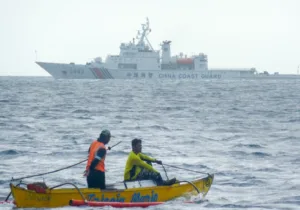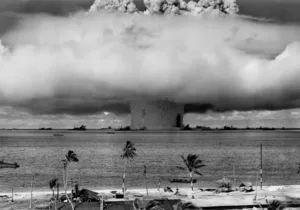North Korea has said that within the next few days it will finalize a plan to fire an intercontinental ballistic missile (ICBM)—which could possibly carry a nuclear warhead—into international waters near the U.S. territory of Guam.
In response to the announcement President Trump said:
North Korea best not make any more threats to the United States. They will be met with fire and fury like the world has never seen…he has been very threatening beyond a normal state. They will be met with fire, fury and frankly power the likes of which this world has never seen before.
A few days later Trump added:
I will tell you this, if North Korea does anything in terms of even thinking about attack—of anybody that we love or we represent, or our allies or us, they can be very, very nervous.
I’ll tell you why…because things will happen to them like they never thought possible. I will tell you this, North Korea better get their act together or they’re gonna be in trouble like few nations have ever been.
After these threats and statements, here is what you should know about the ongoing North Korean missile crisis.
Does North Korea have nuclear weapons?
The U.S. Defense Intelligence Agency (DIA) has concluded that North Korea has successfully produced a miniaturized nuclear warhead that can fit inside its missiles. The estimates are the Kim regime controls between 30 and 60 nuclear warheads.
Does North Korea have missiles that can reach the U.S.?
North Korea completed its first ICBM test on July 4 and a second test later that same month. The range of the missile, according to some estimates, could allow it to reach Alaska.
Why is Guam being targeted?
The Kim regime hasn’t explained why it is threatening Guam, but here are some possible reasons.
The most obvious reason is that Guam is the closest location that has a significant number of U.S. citizens within range of North Korean ICBMs. The island currently has about 7,000 military personnel and 160,000 civilians. An attack that killed both may be attractive to the Korean dictator.
Guam is also home to a squadron of bombers that can deploy nuclear warheads. North Korea has specifically mentioned these bombers “which get on the nerves of DPRK [Democratic People’s Republic of Korea] and threaten and blackmail it through their frequent visits to the sky above Korea.”
Could the U.S. shoot down a missile before it hit Guam?
Probably not. It’s debatable whether the U.S. has a missile defense system that can reliably shoot down an ICBM before it would hit Alaska or the west coast of the Continental U.S. Around Guam there is the Terminal High Altitude Area Defense (THAAD) system, which has not proven it can shoot down an ICBM.
Why doesn’t China intervene to stop North Korea?
The main reason is there is a lack of urgency since there is no direct threat to their country. North Korea has long been able to reach mainland China with nuclear weapons but has shown no inclination to threaten their key trading partner.
China does not want the U.S. and North Korea to go to war, of course, and would likely take steps to prevent that outcome. But China is currently more concerned about the fall of the Kim regime, which would cause military grade weapons (including nukes) to enter the black market, a refugee problem on the 880-mile shared border, and a stronger U.S. presence in the region.
Should we be worried?
Probably not—at least not yet. The North Koreans would be using an ICBM, the Hwasong-12, which they have only tested once. It is also unknown whether the nuclear payload could survive the friction and pressure when the ICBM reentered the planet’s atmosphere. They realize they would be embarrassed if they attempted and failed.
The North Koreans would also have to send their missile over Japan, and instead of striking the international waters off Guam, the missile could accidentally hit the either the U.S. ally or U.S. territory. Because of the possibility of catastrophic error, they would need to be willing to risk a nuclear war and the end of the Kim regime for a saber-rattling “test.”
Guam doesn’t seem to be too worried. The offices of Guam Homeland Security and Civil Defense said in a statement that its threat level remained unchanged, and that it will “continue to monitor the recent events surrounding North Korea and their threatening actions.”
What happens next?
While the rhetoric between the U.S. and Korea will likely remain heated, it’s unlikely that it will lead to an escalation of military action—at least in the near future. As the Rand Corporation notes, “North Korea is a cruel, violent regime, but it is not irrational and not even all that unpredictable. It values regime survival above all else, meaning that classic deterrence is a perfectly good starting point for dealing with the North’s nuclear capabilities.”
The Trump administration may decide that the best option is to maintain an attitude of deterrence in the hope that internal conflicts will distract the Kim regime and prevent further escalation of a conflict that would lead to massive and unnecessary destruction and loss of life.
—
Joe Carter is an adjunct professor of journalism at Patrick Henry College, an editor for several organizations, and the author of the NIV Lifehacks Bible.
Photo Credit: A U.S. Air Force B-1B Lancer sits on the runway at Anderson Air Force Base, Guam on July 18, 2017. U.S. Air Force photo by Airman 1st Class Christopher Quail.







 Live in the DC area? Sign-up for Providence's in-person events list!
Live in the DC area? Sign-up for Providence's in-person events list!